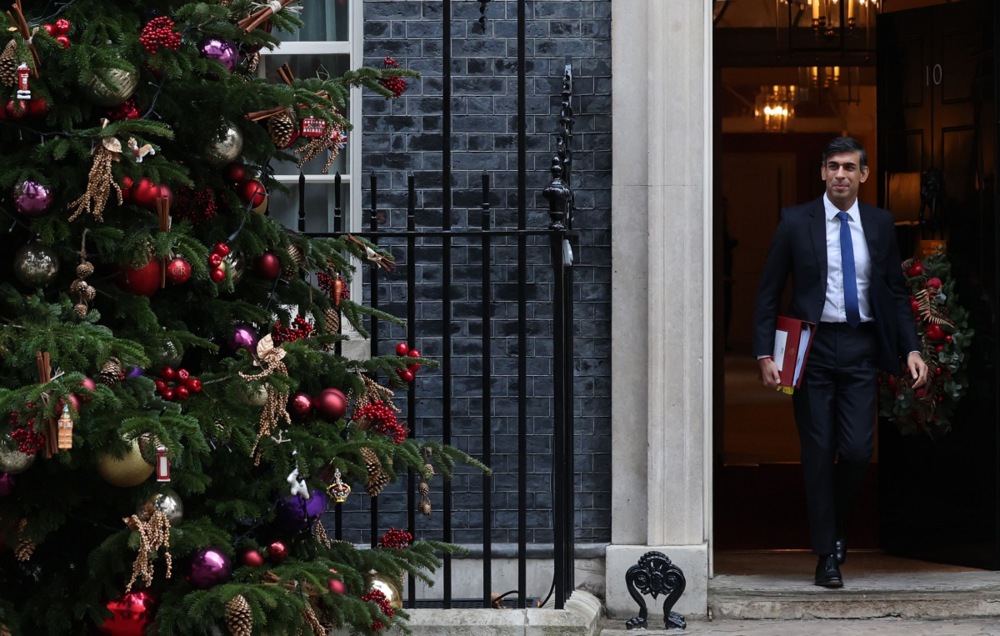With polls now regularly placing Donald Trump ahead of Joe Biden in next year’s US presidential election, the extraordinary prospect of his return to the Oval Office is starting to focus minds across the world. This is particularly the case among America’s European allies who have seen their dependence on Washington drastically deepen since the outbreak of full-scale war in Ukraine last year.
The handwringing has already begun over what Trump II would do in terms of foreign policy and how America’s partners can prepare for impact.
The fact that the same questions are being asked again as in 2016, and the same kind of apocalyptic scenarios are being drawn as eight years ago, shows that few people bothered to really understand Trump’s vision the first time around, let alone to learn anything from what he actually did in office.
That is not to say that there will not be significant differences if he does make it through.
The second coming of Donald Trump will likely stir even greater convulsions in the US body politic than the first time around, not only because society is even more divided – with renewed bouts of hysteria already on display even on the Republican side, let alone among Democrats – but also because in the meantime Trumpism has triumphed within the GOP. The going will be easier in Congress, with Gaetz praetorians now guarding the president’s legislative agenda.
A new Trump administration will also be much better prepared to fight the bureaucratic wars that so crippled its previous iteration.
Concerns have been raised as to the more limited field of higher-calibre figures available to take the top jobs. There will likely be no “stars” like Jim Mattis or H R McMaster to call upon for key national security positions – except perhaps Mike Pompeo. But others will step up; the vast D.C. machine does not lack for talent and expertise, at least in the much-reduced, contemporary American sense of those terms.
Meanwhile, Trump’s extended team has had four years to prepare meticulous plans for what to do policy-wise and how to keep the inevitable bureaucratic rebellion at bay once back in power. So there is a higher chance that more of Trump’s actual vision or doctrine for foreign affairs will be executed if he wins re-election.
Understanding how a second Trump administration might play out in foreign policy terms starts with grasping his fundamental perspective on defence, diplomacy, national security and, in general, on the use of power in international affairs in pursuit of national interests.
For that, we must go back to the beginning – to his 2016 campaign, when as a first-time candidate he had to speak at greater length on these topics than we are likely to hear this time around.
Back to basics
In 2016 Donald Trump laid out his foreign policy views in a number of speeches (27 April, 13 June, 15 August and 7 September) and interviews (especially the 26 March interview with the New York Times).
Of these, the April 2016 speech at the Centre for the National Interest contains the fullest articulation of his vision for world affairs.
To begin with, it is important to note Trump’s starting point in thinking of foreign affairs, his diagnostic of US foreign policy at the end of the Obama administration.
This analysis is largely applicable today as well – not least because Biden’s foreign policy team is staffed with Obama’s people. In Trump’s telling, America’s key problems were – and arguably still are – that:
- America’s resources are over-extended. The economy is weakened (now with a huge deficit on the books). Sorting this out will free resources to build up the US military.
- Allies are not paying their fair share. They have to contribute more financially. In NATO, only four countries met the 2% baseline in 2016 (today eleven do, but the US is Ukraine’s chief military sponsor). The US has spent trillions building up its military. These countries that America is defending must pay for the costs of their defence. If not, Trump, said, the US must be prepared to leave these countries defend themselves. The US has no choice. A Trump administration will lead a free world that is properly armed and funded.
- America’s friends are beginning to think they can’t depend on it. Americans have had a president (referring to Obama in 2016 and applicable to Biden now) who dislikes the US’s friends and bows to its enemies. Furthermore, Iran cannot be allowed to have a nuclear weapon. America has picked fights with “our oldest friends”, and now they’re starting to look elsewhere for help.
- Rivals no longer respect the US. Americans have economic leverage on China that can be used to get them to press North Korea (something which Trump did use to a degree in 2017).
- America lacks a coherent foreign policy and a clear understanding of its goals. The legacy of the Obama-Clinton interventions will be weakness, confusion and disarray, a mess. The US is at war with radical Islam.
How did Trump propose to deal with these challenges?
Again, his ideological anchoring was very explicit in 2016 – and indeed, can be traced throughout his previous career – and undoubtedly remains true today as well. Trump’s grand strategy turned on economic growth. Or, as he put it, “You can’t make America great again unless you make it rich again”.
Therefore, the key element in Trump’s thinking in 2016 was the idea of America’s restored, unquestioned supremacy – once he, as president, will have fixed the economy. Trump will perceive the same imperative in 2024. Biden’s America may be growing at almost 5 per cent in Q3, 2023 but this is fuelled by huge deficit-funded spending.
From this restored future position of economic vitality, Trump’s only logical conclusion was, and is, that he can effectively dictate terms to everyone else in the world. In his words, his America will be able to “walk away” from any negotiation.
Trump sees America’s relations with other countries as something “offered” by Washington, rather than “needed” or “required” by America’s own interests. In a sense this can be seen merely as Trump’s way of actually reviving a long tradition of a true faith in American “exceptionalism”.
Unlike the Democrats and in fact most of his own party, he really thinks America is not just the world’s best or strongest power, but that it is an exceptional, unique power. That is why Trump used to talk in 2016 about the “full-potential America” as a model that can be an inspiration for others, and that in itself can be a way to change the world.
But in recent decades, this historical view of America, inherited from the Founders, has been much diluted and stripped of its inspirational or value-based meaning, and reduced to its simple, power-based core. This has happened largely on the back of the rise of the “cultural Left” and globalist, liberal ideology that actively challenges any “exceptionalist” notions and instead aims for egalitarianism and the “global village” mindset so dear to the Leftist, collectivist mind.
Barack Obama’s entire presidency was about trying to present America as an “ordinary” nation, which is why Donald Trump has often attacked him for his “apology tour”-foreign policy.
The other force eroding “exceptionalism” has been a rising cynicism born of America’s repeated failures, starting from Vietnam and more recently in Iraq and Afghanistan; this has very much undercut the strong moral arguments behind US exceptionalism.
Already in 2016 and even more so today, all that’s really left of the notion of American exceptionalism is a (diminishing) notion of “superpower status” in a military and economic sense. Trump’s instinct seems to be to go back to the more “non politically-correct” version of exceptionalism.
In this sense, on the campaign trail in 2016 Trump specifically emphasised the principle of reinvigorating and promoting true Western values and institutions.
By “promote” he meant to promote them more in our society and fighting against what in 2023 we call “wokeism”, rather than democracy-promotion abroad. Indeed, one of the greatest moments of his presidency was his landmark Warsaw speech in 2017, with its strong statements on the importance of culture, religion and freedom.
An oft-repeated theme in Trump’s 2016 rhetoric was that the US would be a “strong ally” again. He never said he was going to ditch the allies – on the contrary.
But with one condition: that they pay up. Trump was only complaining of “free riding” and that others are not paying their “fair share” – and he pointed to NATO allies who don’t pay 2 per cent. Now, especially after Putin’s attack on Ukraine in 2022, there is wide recognition, even from Trump’s bitterest enemies, that he was correct to raise this criticism.
Crucially, in 2016 Trump was emphatic in wanting to rebuild the US military for “unquestioned” dominance – and his administration moved very aggressively in that direction especially during Jim Mattis’s tenure as Secretary of Defense.
Nothing has changed on this either, as far as Trump’s views are concerned; if anything, he perceives America’s military inadequacies even more acutely today than eight years ago.
On Russia, in 2016 Trump’s stated intent was to improve relations with Russia “from a position of strength”. In the context of the time there was a solid case to be made for this approach, in line with classic Kissingerian détente theory, as previously explained in these pages.
What was lost in the media storm and then in the huge political scandal following Trump’s election and the “Russia hoax”, was Trump’s original intent to try to make a deal with Russia, while being prepared to “walk away”. In the wider framing of his concept of negotiating from a position of strength, this would have been the correct approach.
Critics usually ignored and still ignore the second part of the statement, and imply that Trump is some appeaser. But a fairer view would suggest that he was only thinking in terms of getting a good deal.
Trump obviously did not understand, in 2016 before entering the White House, what a “deal” with Russia would mean, in a political context; he was only expressing his intuition. Very likely he gained a more realistic view of the topic when, as president, he was briefed on the military-strategic aspects of the Russia-NATO balance, many of them classified.
Related to this, let us not forget that it was Trump who reinforced America’s military posture across Eastern Europe after the Obama years, and who also started arming Ukraine.
Another under-appreciated insight into Trump’s mindset is his attitude to war. If forced to fight, Trump declared repeatedly during 2016, the US will fight to win. (“…only if we have a plan for victory with a capital V.”).
No other major political figure anywhere in the West has emphasised the idea of the centrality of “victory” in this way for a long time. Arguably, a key reason for the failure in Iraq and Afghanistan has been a lack of clarity around the “definition of Victory” in these wars. It is therefore not a coincidence that Trump has been the only president in recent decades who did not start any new military adventures.
During the 2016 campaign, Trump also issued a clear and explicit rejection of “globalism” and endorsement of “the nation-state”. What he meant was that “international unions tie us up and bring America down”.
This reflects, on the one hand, a belief that states – not international institutions – continue to be the key actors in solving global problems, which is correct; and on the other hand, it is simply another form of the same critique of “free riders”, coupled with a focus on protecting US interests “first”.
There was also the additional undertone of an anti-liberal/globalist-mindset message in there as well, which reflected Trump’s low regard for organisations that are dysfunctional – like UN or EU. In office, Donald Trump doubled- and tripled-down on these themes. Since then, the Biden administration has continued the trend of viewing the UN system with suspicion, particularly institutions like the WTO and WHO.
Again, another important Trump enunciation from his pre-presidential days that has never been properly understood is that “the world is most peaceful and most prosperous when America is strongest.”
This is a welcome principle and should be the number one article of faith in Western foreign policy writ large, especially going into 2024. Yet we are very far from that – indeed, Europe has increasingly taken a hostile view of the US, even well before Trump.
No other presidential candidate articulated the point about the utility of US strength so clearly in 2016, nor showed that they fully understand the relationship between world order and American strength.
During the Republican primaries, some candidates put their faith in some new “concert” of powers, others in nebulous notions of “aggregate” Western power and alliances etc; few got the point about the singular importance of America. This is what Trump was talking about and, by all accounts, still believes.
The 2016 campaign rhetoric already showed that one of the distinctive, key novelties that Trump would bring to the presidency would be a completely different understanding of the use of force. This was a break with a decades-old – and unnatural, un-historical – trend of placing more and more limits, both legal and conceptual, on the use of force.
It is this element, more than anything else, that promised to mark the Trump age in US foreign policy should the occasion arise. It did so, though in a somewhat limited way, as president Trump massively escalated US operations against ISIS, leading to its complete destruction, and when he took the hugely bold decision to kill Iran’s most popular and effective general, Qassem Soleimani.
Finally, intellectually-honest observers of the 2016 campaign could have clearly seen that the question of Trump’s so-called “isolationism” was a myth. Of course, the “fake news media” and the intellectually-dishonest commentators continued and still continue to peddle it. In fact, in 2016 Trump repeatedly and explicitly said that he was not an isolationist. He literally said: “Not isolationist, I’m not isolationist, but I am ‘America First’.” “America first, yes, we will not be ripped off anymore. We’re going to be friendly with everybody, but we’re not going to be taken advantage of by anybody. We won’t be isolationists — I don’t want to go there because I don’t believe in that. I think we’ll be very worldview [sic!], but we’re not going to be ripped off anymore by all of these countries.” His foreign policy achievements as president, from defusing the 2016-17 North Korea crisis – whose gravity has now been forgotten – to the Abraham Accords between Israel and a number of Arab states, are a testament precisely to this approach.
The confusion over the “isolationism” issue stemmed – and still does – from Trump’s reluctance to fully endorse America’s standing alliances. But that does not mean isolationism. He was explicit about America’s role in keeping the order in the world. Trump simply thought, as far as one can tell, that America was so strong – even in 2016, before he started “making it great again” – that it could keep order in the world in a different way than by relying that much on allies: that is, by shifting to a “Concert of Powers” approach. There is no indication that he has changed his mind on any of that.
The real Trump doctrine
From everything he said during his first presidential campaign – views which, indeed, remained consistent with his subsequent foreign policy actions in office – one can distil a clear set of principles that don’t really have an expiry date and will likely be valid in 2024 as well. This, then, is the “Trump doctrine” for American foreign policy and strategy at least in theory:
- Lead the free world as the exceptional nation.
- Have the strongest military in the world, by a good margin. Aim for “Peace through Strength.”
- Buttress Western values and institutions at home, in the West. Be a “beacon” for the world, inspire by example.
- Reject neo-conservative doctrine (democracy-promotion, nation-building etc).
- Keep allies close, but on a basis of reciprocation (i.e. make them pay their proper dues – because the US cannot afford the costs, going forward).
- When forced to fight, fight with overwhelming military power.
- Reject the “globalism”, divide the world in friends and enemies, and keep the order by cutting deals from a position of strength. But do all this with a clear sense of who’s the enemy, and therefore without “selling-out” friends or helping enemies. Get a “good” deal.
In short, Trump offers a mid-Cold War vision running on mid-19th-century principles. It contains the clarity of who’s on the “good” side and who’s on the “bad” side, the sense of US exceptionalism and the need to preserve Western values (on our side), specific to the mid-Cold War; together with the willingness to negotiate with our adversaries and find a stable balance of power, specific to the Concert of Vienna era.
Trump’s vision – which he never had enough political room and opportunity to enact in office the first time around – may not be entirely feasible. It is certainly simplistic – although good strategy does require simplicity – and some of its aspects are fantastical. But it does have its own logic.
In conclusion
Trump’s foreign policy instinct is to take us straight back to 19th century power politics. He represents a revival of the old school of Realpolitik, and it may be said that since he left office the transformations we have seen in the international system have truly caught up with his 2016 precepts. In other words, his stated perspective on strategic affairs is even more appropriate for today’s world than for that of eight years ago.
If he gets re-elected, is Trump’s vision as president – with its anti-globalist ethos, suspicion of international institutions and resentment of exploitative allies – about to turn America into a sort of “rogue” state that rejects international values, standards and rule of law? How does this square with the actual centrepiece of Trump’s presidential mindset: American exceptionalism and America’s mission to lead the free world?
In actual fact there is no contradiction here, because the set of values that Trump’s America would protect as the “exceptional nation” is a very basic and restricted one. It does not include, for example, the Greta Thunberg package of climate activism, Green policies and Net Zero nonsense.
As he did in his first term, Trump would be harking back to a much older definition of “Western values”. Let us not forget that this notion has expanded wildly in the decades since 1945, together with the rise of international human rights law. What Trump means by “Western values” are really just basic, common-sense things like “freedom” – i.e. freedom from tyranny, freedom to speak against the authorities – and “equal rights”, i.e. no special privileges for minorities and other “identity”-based entitlements.
Does another Trump presidency mean the “withdrawal of American leadership”? It certainly did not in his first term in office, when for example the US led global efforts to expose the reality of Chinese power and to push back against Beijing’s attempts at technological subjugation of other countries in key areas like 5G. But it does mean the continued transformation of that particular notion of “American leadership”.
Under a Trump II administration, America would perhaps be set to become a much more arbitrary power that will be much less sensitive to allied concerns and will act in force when its interests demand it. These interests – even, or especially, under an America First programme – will very likely continue to include the stabilisation and then preservation of global order to the extent possible, and the checking of rivals’ growth.
With Trump back in charge, Left-liberal values and much of the strategic nonsense of the past 30 years that has brought us to our current predicament – with three major military crises on three continents, in Ukraine, Taiwan and Israel – will likely take a backseat. It is impossible to know what he would actually be able to achieve in foreign policy on a second “tour of duty” as US commander-in-chief. But it is possible to have a fairly good sense of how he would like to use American power in the world: for restoring clear US dominance in the international system, with economic and security benefits for all free, democratic and open nations. What other rational choice is there?
Gabriel Elefteriu is deputy director at the Council on Geostrategy in London and a fellow at the Yorktown Institute in Washington, D.C.






Europe’s capital needs media to challenge the status quo: That’s why Brussels Signal is launching